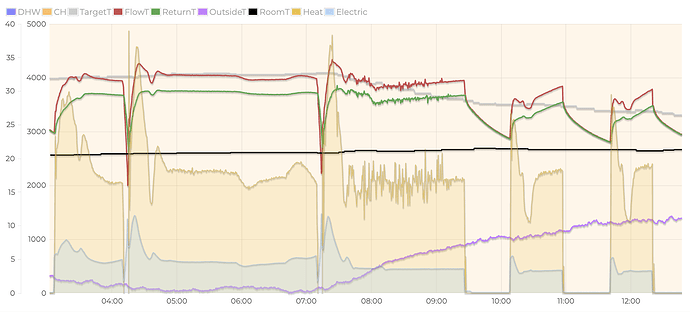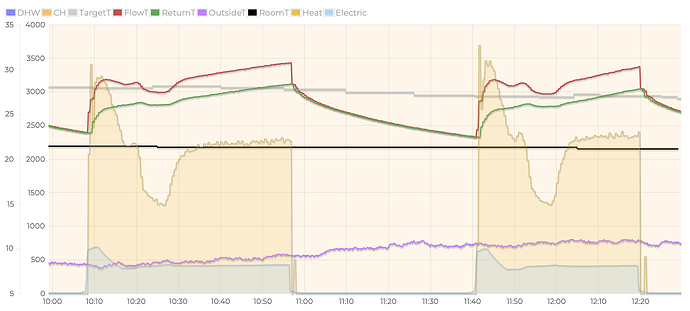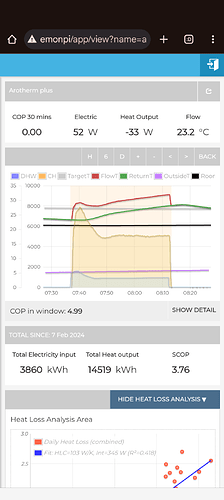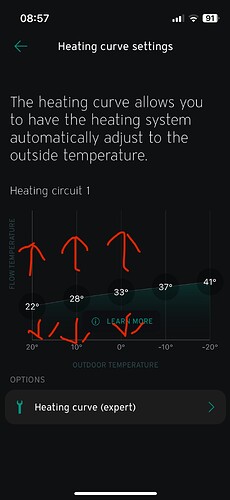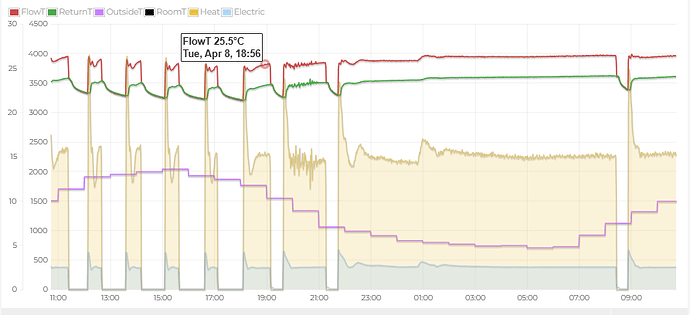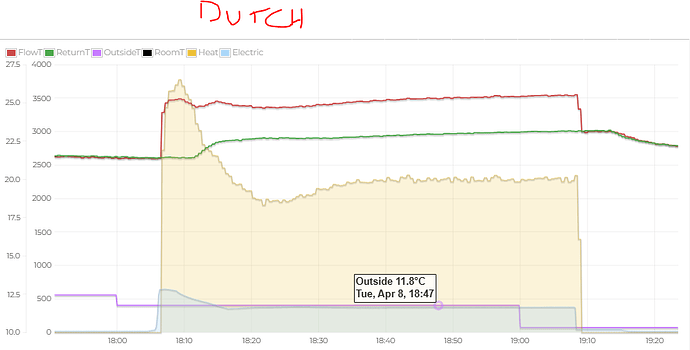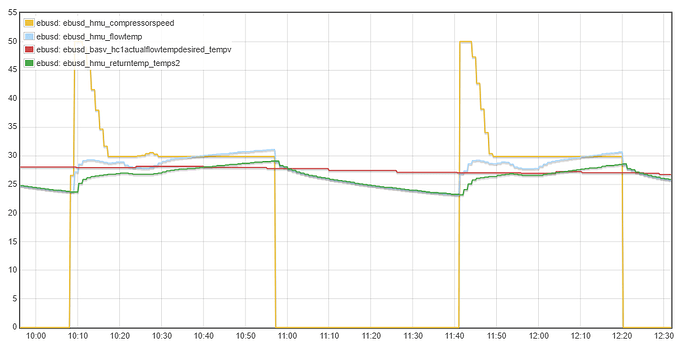Thanks I’ll have a search.
My article here hopefully explains it enough
Thanks, that’s very useful, starting to understand how it’s all working. And that those controllers don’t just look like they escaped from the 80s, they actually did. I can see that setting the hysteria is has very little effect, as the integral just about kicks in first. Setting it to something very low like. 2K would of course change that, but probably not advisable.
I can see one occasion where it kicked in was after the DHW run where the flow temp shot up and caused the system to stop the cycle immediately:
In case anyone interested: in turns out that the EEV was not working at all, it stayed fully open. In the graphs, this would show 5%open. The controller closes the EEV as much as required, but since it was not reacting, steers to maxmimum closure. Now a completely different logical control behaviour. with COP indicatively 4.6 i/o3.6
I’ve turned on the Noise Reduction mode on our system. Compressor reduction is set to 40% as per @Zarch article relating to DHW. We only run it from 09:00 to 23:00 daily anyway (and DHW heated via solar tubes), and run to only 19 deg until 14:00, so I don’t need the compressor to be bringing the water temperature up to heat that quickly.
Emoncms certainly helps to evaluate the results. I have much less cycling as a result, which will absolutely lead to better efficency.
Only thing to be careful of is in really cold weather that you don’t limit the heat pump so much that it can’t defrost.
Mine ended up in some sort of death spiral where the low compressor couldn’t defrost the unit so I ended up with more cycles with less heat output… and rooms not getting to temp. It was only then I realised i’d set noise reduction for the whole 24 hrs… (this was a week prior during some messing / testing).
Who understands Hc1ActualFlowTempDesired ? ![]()
I’m trying to work out why a chosen heat curve like 0.45 works when it’s cold, but then when it warms up a little outside I get room overheating. Despite using active to give room influence.
When using Active mode, this desired flow temp changes depending on how close/far away, the actual room temp is from the target room temp
Examples (me switching the WC curve and flicking between Inactive / Active)
Room Temp: 21.5, Target Room Temp: 20.0
Desired Flow temp reading shown
Curve 0.2 (2.2 diff)
Active: 21.4
Inactive: 23.6
Curve 0.4 (2.5 diff)
Active 23.5
Inactive 26.0
Curve 0.6 (3.0 diff)
Active 25.5
Inactive 28.5
So that makes sense, ‘room influence’ lowers the desired flow temp
and it’s sticking to the 2.5C flow temp difference per 1C of per room temp difference (as seen in the WC curve tables)
BUT, what I don’t understand is why the heat pump doesn’t always seem to adhere to the target when in Active? Especially when it starts to cycle
You can see in this trace the desiredflowtemp is shown in the grey line
All looks good when it’s cold and is in steady state
But when it warms up and starts cycling, it almost ignores the target temp
Let’s look closer
I appreciate that the flow temp rises so that Energy Integral can eventually stop the cycling.
But this behaviour of starting bang on (or above) the desired flow just doesn’t seem right to me.
It’s like it’s sort of running hotter than it should, higher than the curve it’s chosen.
My next experiment might be to see how desiredflowtemp looks in Inactive mode.
That’s exactly the same for me - the initial high-power startup period always brings the flow temperature above target. I think at this point the control algorithm just wants to get the compressor going and doesn’t care about flow temperature really.
Thanks for confirming Andre
The problem is for me, that the target flow temp is what the house needs to balance out / match the heat loss, but the heat pump spends the whole 30 mins of the cycle with the flow temp ABOVE the target.
I really wish you could raise/lower the individual curve points.
So in my case, I would leave the sub 3C temps at say 0.5 curve and then the warmer outside temp closer to the 0.3 numbers.
AND/OR, you could choose how aggressive the Active room influence is. It’s about 2.5C per 1C room difference at the moment. I’d love to be able to double that.
I really think there needs to be more control available to make the unit “fire and forget”.
Whilst we probably enjoy this tinkering, this isn’t good for a regular homeowner who just wants it to work.
There was a good BetaTalk episode on this with @Ken_Bone
I think the issue is that it cannot go lower in the cycling state. Due to reasons unknown to us, you always have the high-power ramp in the beginning, which you cannot get rid off. If you lower the heat curve/target flow temperature, you’ll get a larger overshoot and a shorter cycle - because once the cycling starts the heat output is only modulated via cycle length/duty cycle. The flow temperature achieved during the on-state is as low as possible for the heat pump.
I suppose this system the lowest flow temp a 5kW can go.
This is the top performing 5kW on OEM
What is interesting with this system is that I don’t seem the same behaviour as our two systems. Look at this cycle here
On ours the flow/return rise so that when the return temp crosses the target flow, this invariably means energy integral has kicked in and the cycle stops.
But why does the dutch one not rise the flow as fast?
The system details say no DHW, 16mm UFH, 100mm spacing
Is it cos i’m rads only?
I’d love to know more about the setup of this system. ![]()
It’s not ignoring it, it just can’t modulate lower.
If you look to the rps of the compressor at that times, it’s on his lower speed , 30 rps, it can’t go slower so it can’t produce less power.
That’s why it’s cycling based on how the Energy Intergral is “feeded” with the DT “desired flow temp” - “Flow temp”
The compressor trace is always the same, small rise to 50rps, settles in 30rps
This is the compressor behaviour in those two cycles from my post late yesterday
The compressor trace is the same whether you choose curve 0.2 or 0.6, the only difference being the target temp chosen.
I’m thinking that the rise in these examples is because the target flow temp is too high for the current situation.
So the return comes back high cos it can’t shed the heat.
Energy Integral kicks, so the cycle stops.
Remember in this situation, the room temp was already 1.5C above target (nice sunny day) and despite Active dropping the target flow temp by 2.5C it was still too warm a flow temp (imho) for that situation.
This is why I wish Active would be more aggressive and drop the target flow temp even more or even adjust the WC curve setting on the fly to choose a lower, more appropriate WC curve setting for the situation.
You can see on the dutch screengrab, he doesn’t have the rise, which suggests his WC curve is a better match to his heat loss. Perhaps it was a dull day in Holland yesterday with no solar gain! ![]()
Mick there are 2 energy balance functions. The integral as youve already spoke about, but there is also the compressor hysteresis. Whichever hits setpoint first switches the compressor off.
Under configuration menu of interface, ch compressor hysteresis is factory set to 7⁰C (7k)
So will allow the overshoot of flow temp by 7 degrees before it cuts out. If the system has larger volume where it coukd spend a long time with a little overheat (say target = 28⁰, and you spend a while flowing 32⁰) youll overheat, which is where the integral builds up to 0 and cuts off compressor before the 7⁰ hysteresis is met.
You can lower hysteresis, cycling will increase dependant on volume.
However it shoukdnt affect your overheating of tge house as for every degree minute over it stays off a degree minute longer so balancing the load.
For me its the fact that WC can only see air temp and nothing more. Cant tell if its a sunny day, windy, raining etc, so a higher degree of load comoensation woukd be very desirable.
Unfortunately thats not an option at this time. So a script that automatically changes curve slightly depending on outdoor temps might becan idea to get the best out of it.
Hi Mick, I know the homeowner, what else would you like to know?
Also this behaviour is visible in an other system I have running HeatpumpMonitor.org.
In my view, it has to do with the control of the expansion valve and the state of the refrigerant and the hystereris that is present in the evaporator.
However, I do not have the modbus equipment on the unit in order to measure those variables at a high enough frequency, but I believe the answer to be there.
Just a description of the whole setup really.
Underfloor?
System Volume? Any volumiser in play?
Primary pipework size
Other pipework in play
I need to dig into the work that @John_C is doing to understand this more.
I second an interest in the Schengen system. The main difference I see compared to our vaillant 5ks is that this one is not over specified and most importantly that in steady state this one is consuming about 375W versus ours that use of about 430W+. Given that mine almost never runs above minimum consumptionits obviously very interesting to know if there is anything done to reduce that.
Hi all, is there a setting which maximises the DHW Boost length? I only use the boost mode, triggered by Home Assistant, becuase I’m running Eco mode my HW runs sometimes don’t reach target tank temperature but time out around 60 mins.
You can set the timeout on the room thermostat/controller in one of the installer sub-menus.
